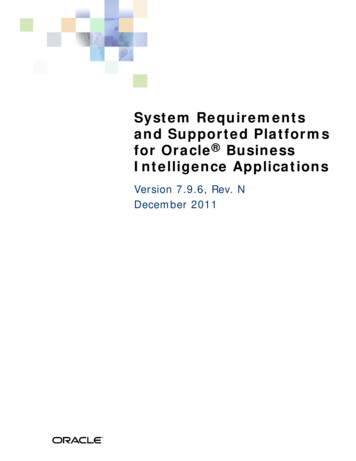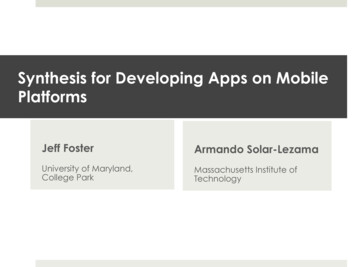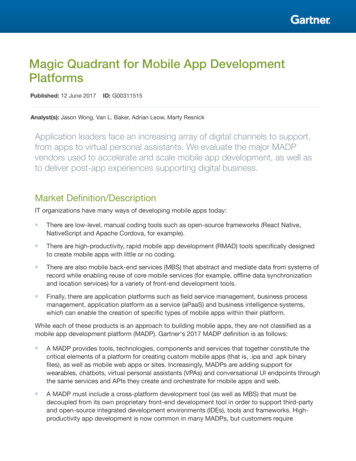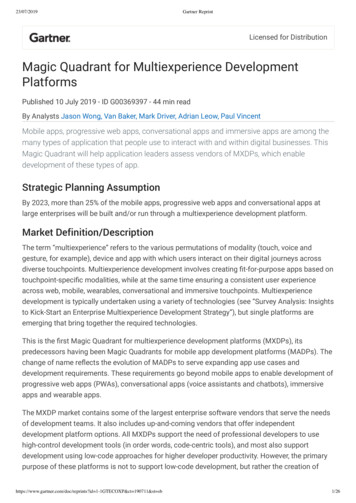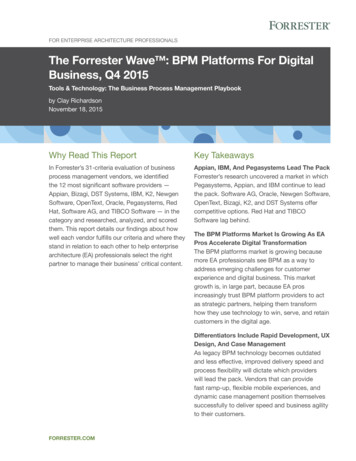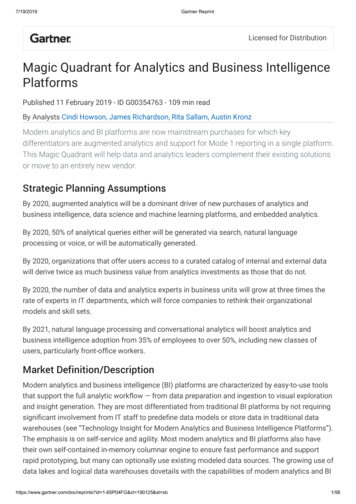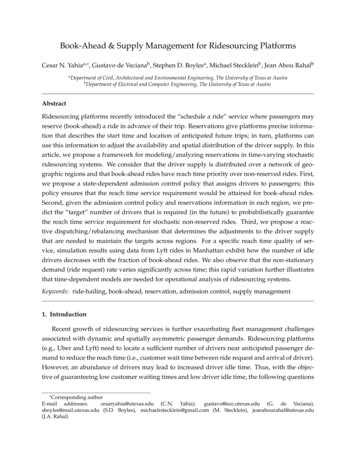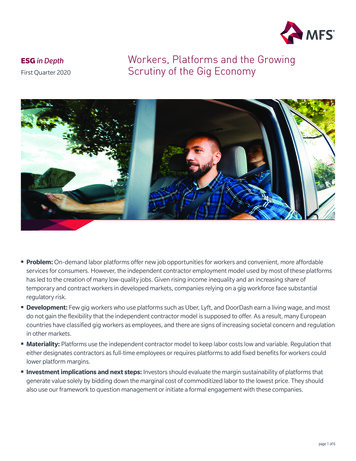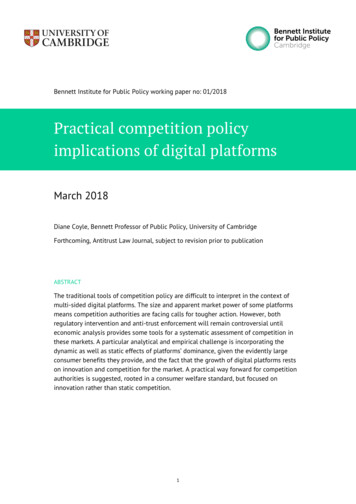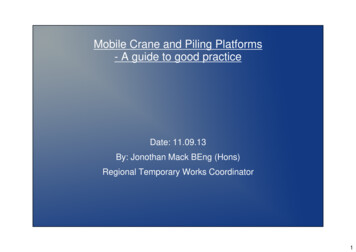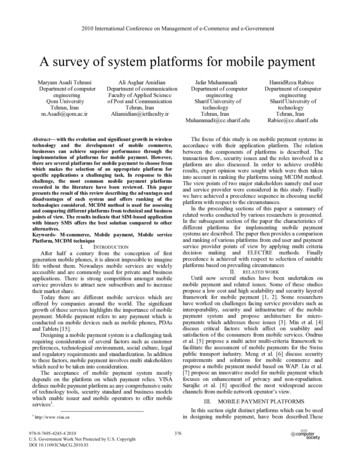
Transcription
2010 International Conference on Management of e-Commerce and e-GovernmentA survey of system platforms for mobile paymentMaryam Asadi TehraniDepartment of computerengineeringQom UniversityTehran, Iranm.Asadi@qom.ac.irAli Asghar AmidianDepartment of communicationFaculty of Applied Scienceof Post and CommunicationTehran, IranAliamidian@ictfaculty.irI.INTRODUCTIONAfter half a century from the conception of firstgeneration mobile phones, it is almost impossible to imaginelife without them. Nowadays mobile services are widelyaccessible and are commonly used for private and businessapplications. There is strong competition amongst mobileservice providers to attract new subscribers and to increasetheir market share.Today there are different mobile services which areoffered by companies around the world. The significantgrowth of these services highlights the importance of mobilepayment. Mobile payment refers to any payment which isconducted on mobile devices such as mobile phones, PDAsand Tablets [15].Designing a mobile payment system is a challenging taskrequiring consideration of several factors such as customerpreferences, technological environment, social culture, legaland regulatory requirements and standardization. In additionto these factors, mobile payment involves multi stakeholderswhich need to be taken into consideration.The acceptance of mobile payment system mostlydepends on the platform on which payment relies. VISAdefines mobile payment platform as any comprehensive suiteof technology tools, security standard and business modelswhich enable issuer and mobile operators to offer mobileservices1.III.MOBILE PAYMENT PLATFORMSIn this section eight distinct platforms which can be usedin designing mobile payment, have been described.Thesehttp://www.visa.ca978-0-7695-4245-4 2010U.S. Government Work Not Protected by U.S. CopyrightDOI 10.1109/ICMeCG.2010.83HamidReza RabieeDepartment of computerengineeringSharif University oftechnologyTehran, IranRabiee@ce.sharif.eduThe focus of this study is on mobile payment systems inaccordance with their application platform. The relationbetween the components of platforms is described. Thetransaction flow, security issues and the roles involved in aplatform are also discussed. In order to achieve credibleresults, expert opinion were sought which were then takeninto account in ranking the platforms using MCDM method.The view points of two major stakeholders namely end userand service provider were considered in this study. Finallywe have achieved a precedence sequence in choosing usefulplatform with respect to the circumstances.In the proceeding sections of this paper a summary ofrelated works conducted by various researchers is presented.In the subsequent section of the paper the characteristics ofdifferent platforms for implementing mobile paymentsystems are described. The paper then provides a comparisonand ranking of various platforms from end user and paymentservice provider points of view by applying multi criteriadecision making and ELECTRE methods. Finallyprecedence is achieved with respect to selection of suitableplatforms based on prevailing circumstancesII. RELATED WORKUntil now several studies have been undertaken onmobile payment and related issues. Some of these studiespropose a low cost and high scalability and security layeredframework for mobile payment [1, 2]. Some researchershave worked on challenges facing service providers such asinteroperability, security and infrastructure of the mobilepayment system and propose architecture for micropayments which addresses these issues [3]. Min et al. [4]discuss critical factors which affect on usability andsatisfaction of the consumers from mobile services. Ondruset al. [5] propose a multi actor multi-criteria framework tofacilitate the assessment of mobile payments for the Swisspublic transport industry. Meng et al. [6] discuss securityrequirements and solutions for mobile commerce andpropose a mobile payment model based on WAP. Liu et al.[7] propose an innovative model for mobile payment whichfocuses on enhancement of privacy and non-repudiation.Sarajlic et al. [8] specified the most widespread accesschannels from mobile network operator’s view.Abstract— with the evolution and significant growth in wirelesstechnology and the development of mobile commerce,businesses can achieve superior performance through theimplementation of platforms for mobile payment. However,there are several platforms for mobile payment to choose fromwhich makes the selection of an appropriate platform forspecific applications a challenging task. In response to thischallenge, the most common mobile payment platformsrecorded in the literature have been reviewed. This paperpresents the result of this review describing the advantages anddisadvantages of each system and offers ranking of thetechnologies considered. MCDM method is used for assessingand comparing different platforms from technical and businesspoints of view. The results indicate that SIM-based applicationwith binary SMS offers the best solution compared to otheralternatives.Keywords- M-commerce, Mobile payment, Mobile servicePlatform, MCDM technique1Jafar MuhammadiDepartment of computerengineeringSharif University oftechnologyTehran, IranMuhammadi@ce.sharif.edu370376
platforms include SMS, USSD, WAP/GPRS, phone-basedapplication, SIM-based Application, dual chip phone, dualslot phone and SRCN2. Based on the communication channelin payment (SMS, USSD and WAP/GPRS), phone and SIMbased solutions can be divided in three platforms.provided by this platform include electronic content purchaseand reservation (ticket, restaurant ) [8, 18].A. Pure SMS platformNo special software has been used in this platform. Thecommunication channel between user and payment networkis SMS. Here a standard format is used for sending messagessuch as timestamp, random number, from account, toaccount, amount, currency, and target mobile number. Thepayer authentication is based on payer mobile number andPIN. Because of security problem related to PIN a safersolution is achieved by one time password. Some of mobileservices which can be provided by this platform include billpayment, financial operation like account history and fundstransfer [10, 11]. These platforms have been shown in Fig.1.Figure 2. The architecture of mobile payment platform based on USSDC. WAP/GPRS platformIn fact this is an alternative for payment through Internetby using mobile phone. Authentication of the payer will bedone by digital certificate, mobile phone number and PIN.An URL link in mobile phone download associatedcertificate. Transferring of information routed by GPRSnetwork and WAP enabled phone. WAP uses a speciallanguage WML for communication Between WAP Gatewayand content on the Internet. The WAP Gateway convertsbetween WML and HTML, allowing delivery of WAP basedcontent to a WAP capable mobile device [19, 20]. As shownin Fig.4 user sends the request through GPRS network, WAPgateway routed the request to content server. As mentionedin previous section, bank operation will be done by paymentserver with the banks involved. Some of mobile serviceswhich can be provided by this platform include financialoperation and web store purchase [10, 11].Figure 1. The architecture of mobile payment platform based on SMSB. USSD platformUSSD is a capability of GSM network which can be usedfor transferring information between mobile phone andapplication. User requests a service by entering short code onmobile. Format of code is standardized and content isspecified for each service, the content can be containingUSSD code, from account, to account, amount, currency,target mobile number. USSD gateway service providercommunicates with GSM network through SS7 protocol. Asshown in Fig.3, user sends a USSD request to USSDgateway. USSD gateway makes a session and route sessioninformation to suitable application. The application sendsback this information to USSD gateway in XML form.USSD gateway makes USSD message and sends back touser. Bank interaction can be done by payment server withthe banks involved. Some of mobile services which can beFigure 3. The architecture of mobile payment platform based onWAP/GPRS2short ranges communication network377371
applications. 3 It has many useful features such as datasecurity, speed enhancement and anti- conning mechanisms.STK menu with WIB-based programming can be updatedspeedily through OTA and SMS. A sample of this system isproposed by Rahimian et al.[14]. Some of mobile serviceswhich can be provided by this platform include financialoperation, electronic and physical good purchase, reservation(ticket, restaurant, etc). The architecture of this platform hasbeen shown in Fig.5.D. Phone-based application platformIn this platform, payment software installed on mobilephone and payment operation will be done through thissoftware. A communication channel (SMS, USSD andWAP) will be needed for transferring payment informationonto mobile payment system. Depending on which channelis used, cost, security and accessible services will bedifferent. J2ME or BREW is a tool for developing paymentsoftware according to GSM or CDMA network. Thedisadvantages of this platform include: applicability only onJAVA enabled phone, manual installation and update,duplicate installation in case of phone exchange and differentversions required for various phones. Nonetheless, theadvantages of using J2ME are end to end security, contentencryption and improvement of network bandwidthusage[21,22]. Some of mobile services which can beprovided by this platform include financial operation,electronic and physical good purchase, reservation (ticket,restaurant, etc). The architecture of this platform has beenshown in Fig.4.Figure 5. The architecture of mobile payment platform based on SIMbased applicationF. Dual chip phone/ dual slot phone platformSome of phones have the ability to keep two chips, oftenone of them is SIM-card and the other one is a payment cardwhich permanently place in the phone. The Personalizedinformation will be provided by the second card. EMPS is ajoint product of three companies; VISA, Noreda bank andNokia, in which payment is processed, is in this way 4 .Currently this project is in pilot phase. Some phones areequipped with second slot in order to initiate a payment.User should place the second card on the phone and start thetransaction by entering related PIN number. Some of mobileservices which can be provided by this platform includefinancial operation, electronic content purchase, reservation(ticket, restaurant .). The architecture of this platform hasbeen shown in Fig.6.Figure 4. The architecture of mobile payment platform based on phonebased applicationE. SIM-based application platformThis platform is based on application installed on SIM.User receives payment software and other services directlythrough OTA server. When the software is successfullyinstalled, user can send a request for supported services ontooperator. This request is processed in OTA server andrecorded on transaction server. This platform enables user toencrypt the messages, OTA server decrypts the messages byHSM which include encryption keys. It should be noted thatbinary SMS used in this platform is different from normalSMS. Binary SMS allows the sending of rich content via textmessage in encrypted form and also it does not reside on thephone; it is just kept on SIM. Tool for developing this typeof application is called SAT. SIM-application toolkit enablesSIM to provide value-added services [23]. It consists of a setof instructions programmed in SIM which specify how tointeract with outside of network. A special SIM-card calledWIB-card is a suitable product for mobile operator wishingto deploy a wide variety of value-added services andFigure 6. The architecture of mobile payment platform based on dual chip/dual slot urope.com/ press & media.
w j i wG. Short range communication network platformIn this platform purchase information can be sent throughshort range communication network like Bluetooth, NFCtechnology and IRDA to the POS or vending machine andthe user is charged with phone bill. This method of paymentis suitable for micro payment and adopted with operatorcentric business model. Some mobile services which can beprovided by this platform include electronic and physicalgood purchase and reservation. The architecture of thisplatform has been shown in Fig.7[17].jw j i wjw j i w jThe discordance index for two alternatives h, k is definedas follow:D j ( h , k ) (( g j (A h ) g j (A k )) / max j i ( g j (A h ), j ) h , k ; h kWhere g j ( A h ) is the performance value for alternativeAh in criterion j. j refers to the R-degree parameter used bya decision maker for criteria j to represent the degree ofattention paid by the decision maker to criteria j. Both indexvalues are then compared with the respective thresholds p , qto determine their significance.con (a , b ) pca strongly prefer to bq c con (a , b ) pc a weakly prefer to bcon (a , b ) qca and b are indifferentb strongly prefer to adis (a , b ) pdq d dis (a, b ) pd b weakly prefer to adis (a, b ) qda and b are indifferentFigure 7. The architecture of mobile payment platform based on SRCNIV. MCDM MODEL: MOBILE PAYMENTPLATFORM AND EVALUATION CRITERIACriteria from two perspectives; end user and paymentservice provider, have been used in ranking of mobile systemplatforms. The ranking has been carried out by applyingMCDM model and ELECTRE method. MCDM modelenables selection of best possible option from a number offeasible alternatives in the presence of multiple, usuallyconflicting criteria [9].B. Evaluation criteriaSelection of suitable platform for designing mobilepayment system depends on several factors. These factorsmay vary or at least they have different importance degreefor user and provider. The criteria from user point of vieware presented in Table.I. These criteria have been reported byother researchers in the literature [5, 16, 17].TABLE I. USER CRITERIA IN MOBILE PAYMENT PALTFORMS COMPARISONA. ELELCTRE methodIn ELETRE method, the evaluation criteria andalternatives will be specified for a decision. The importancedegree of each criterion has to be specified by obtainingexpert opinion. For example in this study, MCCI5, the leadermobile network operator in Iran, and a number of banks haveparticipated in determining these values.In order to clarify how the results were obtained, wepresent a brief description of this method before applying itto collected data.Assume that A, I, W represent respectively a set offeasible alternatives, evaluation criteria and weights ofevaluation criteria [12].The concordance index for two alternatives index h, k isdefined as follow:c (h , k ) w / (w w w )costsecurityEase of emote accessmembershipintegrationLess operationUser PreferencesEasydownloading diationauthenticationCriteria from payment service provider viewpoint are asfollowing: Security: this criterion represents the level ofsecurity a provider should consider, securitymechanism, encryption algorithm and theimplementation issues [16, 17]. Cost: can be in form of fixed cost and variable costrelated to transaction [13]. h , k ; h eMobile Communication Company of Iran379373
TABLE IV. Q UESTIONATY RESULTS OBTAINED BY EXPERTS OPINIONSSuitable thresholds for concordance and discordanceindex. The ranking of platforms is given below:A7 A1 A2 A9 A4 A8 A3 A6.A5 A11 A12 A10The results show SIM-based application with binarySMS is the best solution in comparison with others. It shouldbe considered that the ranking is country specific and theresults presented in this paper relate to Iran and hence maynot be applicable elsewhere. Cultural and customization conditions: determiningwhich platforms attract more users and hence moresuited to a particular country .[proposed by authors] Ease of implementation: impact of ease ofimplementation on system design [proposed byauthors] Global standards: impact of global standards onsystem implementation [17]A summary of all criteria and alternatives considered aregiven in Table II and Table III.TABLE II.C1C2C3C4C5C6C7C8C9V. CONCOLUSIONIn this paper eight possible platforms for mobile paymenthave been described. For each platform the architecture,involving roles, transaction flow and security has beendetermined. By using MCDM method and ELECTEtechnique we have compared the platforms according toevaluation criteria. The criteria have been considered fromtwo viewpoints end user and service provider. The resultsshow the importance degree of each criterion will bedifferent according to the stakeholder involved. For instance,service providers are expected to view the criteria fromdifferent perspectives compared to end users having differentpriority. The results suggest that SIM-based application withbinary SMS is the best solution for Iran.For future research it is suggested to examine othercriteria from different stakeholders’ viewpoints. Also othertechniques in MCDM such as AHP, linear programming andetc should be used for comparison of platforms. Needed timefor system development and SLA concept in proposingmobile service are remarkable problems for assessment ofmobile payment systems which have been not considered inthis paper. Obviously more general surveys need to beconducted on mobile payment platform to operationally testthe platform in any given situation that would be difficult oreven impossible task. . However, the preliminary studyreported in this paper is considered to assist with futureresearch.USER AND SERVICE PROVIDER CRITERIAcriteriaEase of useSecurity (end user)Cost(end user)Technical acceptabilitySecurity (service provider)Cost (service provider)Cultural and customization conditionEase of implementationGlobal standardTABLE III. ALTERNATIVES IN MOBILE PAYMENT veSMSUSSDWAP/GPRSphone-based application with SMSphone-based application with USSDphone-based application with WAP/GPRSSIM-based application with SMSSIM-based application with USSDSIM-based application with WAP/GPRSDual chip phoneDual slot phoneSRCNC. Data collection and comparison resultsFor collecting data a questionnaire was prepared in orderto seek experts’ opinion regarding importance of eachcriterion and also the supportability of each platform inrespect to these criterions.Table IV shows the results obtained from sending out thequestionnaire by applying ELECTRE method on gathereddata, the concordance and discordance have been tabulated.The ranking of platforms has been determined by specifyingACKNOWLEDGMENTThe work presented in this paper was supported byMobile Value Added Services Laboratory (VAS Lab) ofSharif University of Technology (SUT).We would like to thank Mobile CommunicationCompany of Iran (MCCI) for their assistance in this research.380374
[21] McKitterick, David A Web Services Framework for Mobile PaymentServices, master thesis in university of Dublin , September 2003.[22] Agarwal Shivani, Khapra Mitesh, Menezes Bernard and Uchat Nirav,Security Issues in Mobile Payment Systems " , computer society ofindia.[23] Nambiar seema , Lu chang-tien, R.Liang Lily, "analysis of paymenttransaction security in mobile commerce", Information Reuse andIntegration, Proceedings of the 2004 IEEE International Conferenceon, [12][13][14][15][16][17]X.Zheng , D.Chen. Study of mobile payment System. Proceedings ofthe IEEE International Conference on E-Commerce (CEC’03), IEEEcomputer society 2005.M.Lal Das, M.Saxsena and V.Gulati. a security framework for mobileto mobile payment network. Proceeding of the ICPWC’05, IEEEcomputer so
payment, financial operation like account history and funds transfer [10, 11]. These platforms have been shown in Fig.1. Figure 1. The architecture of mobile payment platform based on SMS B. USSD platform USSD is a capability of GSM network which can be used for trans
